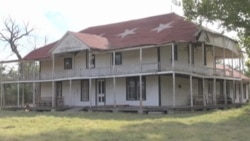One of the most fascinating people in U.S. history was Quanah Parker, the last chief of the American Indian tribe, the Comanche. He was the son of a Comanche warrior and a white woman who had been captured by the Indians.
Parker was a fierce warrior until the day in 1875 when he led his people to Fort Sill, Oklahoma, and took on a new, peaceful life. Quanah’s image remains strong among his people, but part of his heritage is in danger of disappearing.
After giving up the warrior life and settling on the reservation, Quanah Parker became an advocate for his tribe. That earned him the respect and friendship of such notable figures as President Theodore Roosevelt.
Setting precedent
Bruce Caesar, a Pawnee American Indian, said he admires the Comanche, and he credits Quanah for their success running businesses, like casinos, while keeping the tribe's identity.
“He did an outstanding job of bringing his people into contemporary society, where now they are one of the powerhouses of the sovereign nations in Oklahoma,” said Caesar.
But the most remarkable physical reminder of Quanah Parker is slowly falling into ruin on this lot behind a trading post here. Parker’s house was where he lived with his family and entertained many notable guests.
Texas cattlemen who had successful dealings with Parker built him this large home in 1890. It is known still known as the Star House for its roof decorations.
Quanah’s mother Cynthia Ann Parker died before he surrendered, but he later kept her picture by his bed.
Star House
The Star House today belongs to Wayne Gipson and his sister, who inherited it from their uncle, who obtained it through a trade with Quanah Parker’s daughter in the 1950s. Quanah's daughter left the future of Star House up to the Gipson's uncle.
“... if anything is to be done with the Star House, she felt it would be up to him, and if he would trade her a livable house for the Star House, she would go along with the trade,” said Gipson.
Gipson admitted he lacks the funds to properly maintain the old structure. “We had worked toward getting some funding for it, but it is basically at a standstill currently.”
Quanah Parker's descendant Tina Emhoolah said the Comanche Nation has offered to buy the house, but Gipson would not sell.
“It is unfortunate that the property has deteriorated the way that it is, but the nation has made its offer; they chose not to take it,” said Emhoolah.
Establishing priorities
Caesar said that while preserving history is important, the Comanche Nation should use its funds on more current needs.
“If you have some money to spend, it is better to spend it on jobs, benefits for the people, health, education, housing, food,” he said.
Emhoolah regrets what has happened to the Star House, but she's philosophical about it.
“Quanah’s history is still a wonderful thing. You can own the building, but you will never own his history. The Comanche Nation, his history belongs to us," she said.
The Comanche Nation continues to seek agreement with the owners on how to save the Star House.






